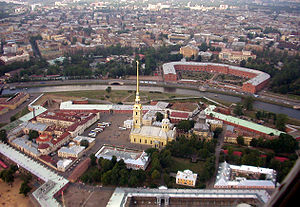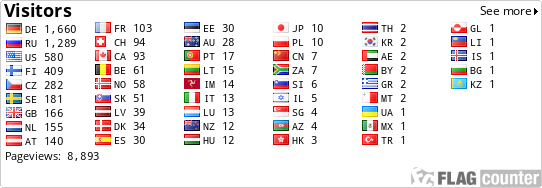
Peter and Paul Fortress
The Peter and Paul Fortress is the original citadel of St.Petersburg, Russia, founded by Peter the Great in 1703 and built to Domenico Trezzini's designs from 1706-1740.
The fortress was established by Peter the Great on May 16 1703 on small Hare Island by the north bank of the Neva River, the last upstream island of the Neva delta. Built at the height of the Northern War in order to protect the projected capital from a feared Swedish counterattack, the fort never fulfilled its martial purpose. The citadel was completed with six bastions in earth and timber within a year, and it was rebuilt in stone from 1706-1740.
From around 1720, the fort served as a base for the city garrison and also as a prison for high ranking or political prisoners. The Trubetskoy bastion, rebuilt in the 1870s, became the main prison block. The first person to escape from the fortress prison (now an important destination for tourists) was the anarchist Prince Peter Kropotkin in 1876. Other people incarcerated in the "Russian Bastille" include Shneur Zalman of Liadi, Tsarevich Alexis, Artemy Volynsky, Tadeusz Kosciuszko, Alexander Radishchev, the Decembrists, Grigory Danilevsky, Fyodor Dostoevsky, Mikhail Bakunin, Nikolai Chernyshevsky, Josip Broz Tito and, last but not least, my great-grandfather.
During the February Revolution of 1917, it was attacked by mutinous soldiers of the Pavlovskii regiment on February 27 and the prisoners were freed. Under the Provisional Government hundreds of Tsarist officials were held in the Fortress.
The Tsar was threatened with being incarcerated at the Fortress on his return from Mogilev to Tsarskoe Selo on March 8 , the threat was not followed through and he was placed under house arrest. On July 4 when the Bolsheviks attempted a putsch the Fortress garrison of 8,000 men declared for the Bolsheviks. They surrendered to government forces without a struggle on July 6 .
On October 25, again, the Fortress quickly came into Bolshevik hands. Following the ultimatum from the Petrograd Soviet to the Provisional Government ministers in the Winter Palace, after the blank salvo of the Cruiser Aurora at 21.00, the guns of the Fortress fired 30 or so shells at the Winter Palace. Only two actually hit, inflicting minor damage, and the defenders refused to surrender– at that time. At 02.10 on the morning of October 26 the Winter Palace was taken by forces under Vladimir Antonov-Ovseenko, the captured ministers were taken to the Fortress as prisoners.
The Provisional Government ministers were the last prisoners at the Fortress. In 1924, most of the site was converted to a museum. In 1931, the Gas Dynamics Laboratory was added to the site. The structure suffered heavy damage during the bombardment of the city during WW II by the German army who were laying siege to the city. It has been faithfully restored post-war.
The fortress contains several notable buildings clustered around the Peter and Paul Cathedral (1712-1733), which has a 123.2 m (404 ft) bell-tower (the tallest in the downtown) and a gilded angel-topped cupola.
The cathedral is the burial place of all Russian tsars from Peter I to Alexander III, with the exception of Peter II. The remains of the Imperial martyrs, Nicholas II and his family and entourage, were also interred there, in the side St.Catherine's Chapel, on the 80th anniversary of their deaths, July 17, 1998. Towards the end of 2006, the remains of Dowager Empress Maria Feodorovna were brought from Roskilde Cathedral outside Copenhagen to finally rest next to her husband, Alexander III.
The newer Grand Ducal Mausoleum (built in the Neo-Baroque style under Leon Benois's supervision in 1896-1908) is connected to the cathedral by a corridor. It was constructed in order to remove the remains of some of the non-reigning Romanovs from the cathedral where there was scarcely any room for new burials. The mausoleum was expected to hold up to sixty tombs, but by the time of the Russian Revolution there were only thirteen. The latest burial there was of Nicholas II's first cousin once removed, Grand Duke Vladimir Cyrilovich (1992). The remains of his parents, Grand Duke Cyril Vladimirovich and his wife Viktoria Fyodorovna, were transferred to the mausoleum from Coburg in 1995.
Other structures inside the fortress include the still functioning mint building (constructed to Antonio Porta's designs under Emperor Paul), the Trubetskoy and Alekseyevsky bastions with their grim prison cells, and the city museum. According to a centuries-old tradition, a cannon is fired each noon from the Naryshkin Bastion. Annual celebrations of the city day (May 27) are normally centered on the island where the city was born.
The sandy beaches underneath the fortress walls are among the most popular in St. Petersburg. In summer, the beach is often overcrowded, especially when a major sand festival takes place on the shore.
You will find the cache inside of the fortress. When you walk over the bridge, don’t miss the hare on the left side of the bridge. You can throw a coin to it. Make a wish before  In case you hit the pole and it stays there, it brings luck
In case you hit the pole and it stays there, it brings luck 
Please be cautious because of the muggles!
Happy Hunting!

Small note on cache maintenance: There is a local cache guardian who will assist.
Name and contact info on file with geocaching.com.